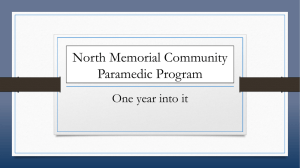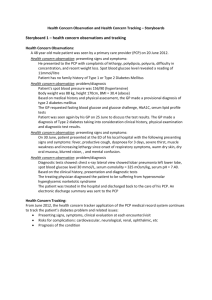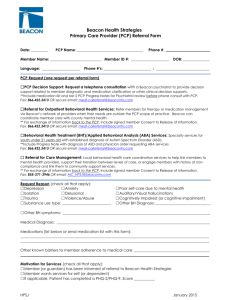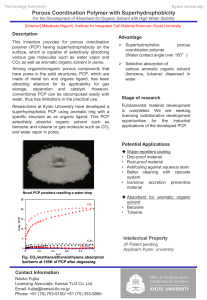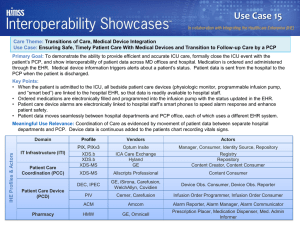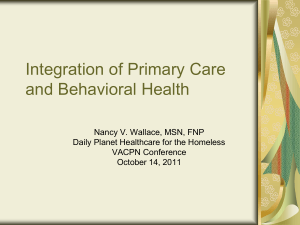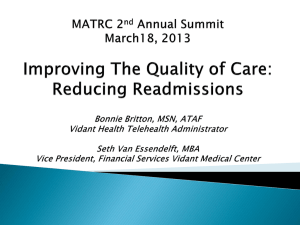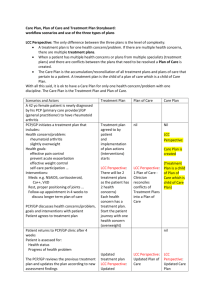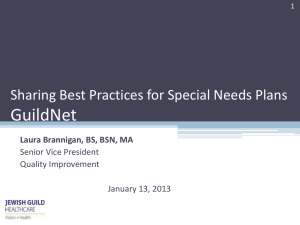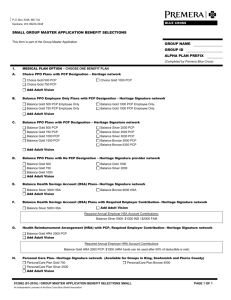Person-Driven Planning
advertisement
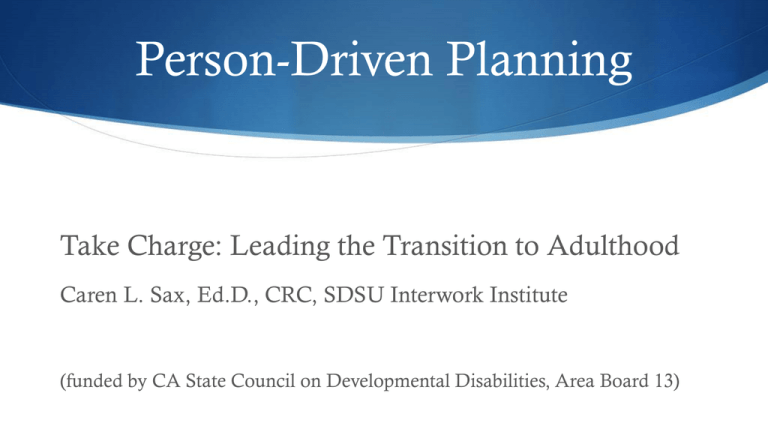
Person-Driven Planning Take Charge: Leading the Transition to Adulthood Caren L. Sax, Ed.D., CRC, SDSU Interwork Institute (funded by CA State Council on Developmental Disabilities, Area Board 13) Top 10 Responses to: Do you do Person Centered Planning? 10. It takes too much time. 9. I can’t draw. 8. Students might have unrealistic expectations. 7. Parents/teachers might have unrealistic expectations. 6. Scheduling everyone is too complicated. 5. I used to do it – not sure why I stopped. 4. I can barely get through the IEPs for everyone. 3. Sounds good in theory – no one really does them. 2. Who’s going to pay for the food? 1. Of course we do!! S COMPONENTS OF PCP/PDP Self determination Relationships High Expectations PURPOSE: TO INFORM ACTION THAT MAKES LIFE BETTER FOR PEOPLE WITH DISABILITIES AND THE PEOPLE WHO KNOW THEM & LOVE THEM Where did it come from? Person-centered planning grew out of a commitment to inclusion as a social goal, intentionally designed as an inclusive process; person-driven planning is an attempt to ensure that the individual is in charge of their plans. IMPLEMENTATION: 1. What does it take for people to gain access to an effective way to plan? 2. What does it take to move plans into action that makes a positive difference in people’s lives? Planning Challenges: Are we really using a persondriven approach to support? Are we letting the PCP drive the forms? People’s Hopes & Dreams Is it customized or are we fitting a “square peg” into a round hole? Supports & Services Skills & Capacities Are professionals adequately trained? What’s the Difference? PCP/PDP Traditional planning S Goals fit within existing program options S Roles & boundaries are clear S Professional takes the lead S Done on schedule according to compliance requirements S Goals reflect individual choices S Roles & boundaries are created according to needs S Student takes the lead and/or plays an active role (depending on age) What it is & What it is not S Deficiencies Capacity/ Talents Thinking beyond what’s currently available S Fitting into existing slots S Controlling the person Empower ment/self -determination S Filling out forms S Compliance “It was really different from a 2hour meeting where everyone else made decisions about my life!” ~J IT TAKES A CHANGE OF PERSPECTIVE What could you do differently to learn about your child/student who is the focus of a Plan? What could you do differently to listen to the family/professionals? What could you do differently to explore possibilities in the community? What could you do differently to create options within the system? The Flow of the Plan Celebrate the little things; what are we learning? What’s next? Action plan – who will do what? Gathering history; how did we get here? MAP What does s/he want, need? Dreams, visions for the future Nightmares, things that may get in the way Strengths, interests, choice, preferences What we’ve done so far . . . S Introduced the concept and strategies to RCP graduate students S Provided training to those interested in committing to project S Presented information/recruited families S Facilitated pre-meetings and meetings designed to be “person- driven” LUKE’S ADVENTURES PATH & HISTORY DREAMS FOCUS ON SHORT TERM S Plan was specific to his needs S Helped to introduce, provide context for support person S Immediate steps Nikki’s Awesome Meeting For the non-artists among us: S Using a template, customized by student, recording directly on computer and shown via a projector; accessing Google Drive, images, photos, etc. ***'s Future Planning Meeting ***'s History Born: May 21, 1991 in Russia Welcome to the USA (5 years old); Directly to San Diego; adopted with his brother (Timmy) Learned English at home, started Kindergarten at 6 years old; met Robby during Elementary school Went to Solana Santa Fe for 4rd-6th grade Travelled to Grand Canyon, up the coast Started to play soccer, went to Warner Springs, played little league, golf, skiing; enjoyed dancing and playing the drums Canyon Crest for 2 years Started USC, then to Springall, then to USC Youth Group at Church ; last 2 years participating in “Young Life”, activities include singing At 18 moved to out to a “home”, then moved to current group home Today: November 27, 2012 What Works? • • • • • • • • • • • • • • • take deep breaths or take a walk when frustrated prompts to take a break small groups, writing things out, a calm relaxing environment being outside being given a job/clear role setting a short-term goal and then extending giving space to calm down giving choices taking breaks waiting until he is calm to bring up an issue privacy tasks with an end point physical tasks bussing tables creating rapport What Does NOT Work? • • • • • • • • • • • getting “in his face” telling him to calm down being forced to “talk about it” teasing confronting an issue when agitated talking about personal issues in a group food service (crowded) crowds/chaos, feeling rushed having to problem solve a task public feedback talking about *** in his presence without including him PLANS WHO • • ***, USC staff WHAT • Get a driver’s license (take written test – book learning, behind the wheel training) or mobility training • Get a job with support, continue with tours of programs ***, USC staff • • • • • start after Winter Break • tours are on-going • No rush, in the future (by age 25) • After getting and maintaining a stable job • On-going • Start after Winter Break Get married ***, Erin • Research sports and dance options (leisure activities) • Go to a trade school (e.g., ITT Tech) or Job Corps *** ***, USC staff, Regional Center • Move to a less restrictive living environment/ supported living ***, parents, Regional Center • WHEN Maximum Participation S Use PCS symbols S Google images S Photos S Do a “pre-plan” to help for better preparation S Make sure that the focus individual selects the participants (may need to prioritize) S Schedule prior to IEP/ITP/ISP meetings S Customize it for more interest J’s PATH - Use of Google images and other internet sites to illustrate J’s dreams J’s mom: “Thank you for allowing Jory to reach for dreams as we sat in delight watching him come to terms with something completely new!” Translating the PCP into required plans/forms: Helps to create long-term goals, specific and measurable objectives for education, transition, employment plans Aaron’s Plan S Aaron was headed into final year of high school (age 18) S Transition goals needed more details, more direction S Met with Aaron and his mom twice before PCP meeting for initial planning & preparation Planning with Aaron – at home with family & friends Translating ideas to his school transition plan Made transition goals more specific S Identify job sites/environments to visit S Set up opportunities to job shadow (pet stores, animal shelters) S Explore details as to why certain jobs/environments were selected (insulation spraying; repairing slot machines) S Try out various tasks for specific jobs (related to family deli) S Identify options for volunteer work to address interest in helping people(senior center) S Begin training on public transportation Comments About PCP Meetings S “This was a great way to get a lot of input on a student who was new to my caseload.” -- Teacher S “This is beautiful.” – Parent who took pictures of the PCP at the end of the meeting S 2 teachers and 1 parent asked if they could have a PCP S “I’m glad all of you could be at my meeting. You’ve really helped me.” –Student S “That was really cool!” –Student S “Thanks for helping my son to dream” - Parent Guiding Principles S The individual is in charge: they decide who attends the meeting, where it should be, and what goes on their plan. S The meeting must be voluntary for all attendees – and everyone must agree to stay for the whole plan. S A pre-meeting is held to interact with the focus-person and family to determine the goal and logistics for the meeting and to determine how to best support the individual to be fully engaged in the meeting. S Everyone must attend a meeting with an open mind, allowing for the opportunity to think in new ways, investing in a different way to dream and attain dreams. S Share ideas that are positive and possible! How to get started: S Be willing to go by the guiding principles; enable and allow for a “person-driven” approach. S Contact Kristoffel (kvandeburgt@gmail.com or Caren (csax@mail.sdsu.edu) S Start planning the food! “A true community is only able to grow and strengthen itself by including all of its members and finding room for them to develop their capacities within its own pattern of growth.” -John McKnight http://whatcanyoudocampaign.org BECAUSE video
